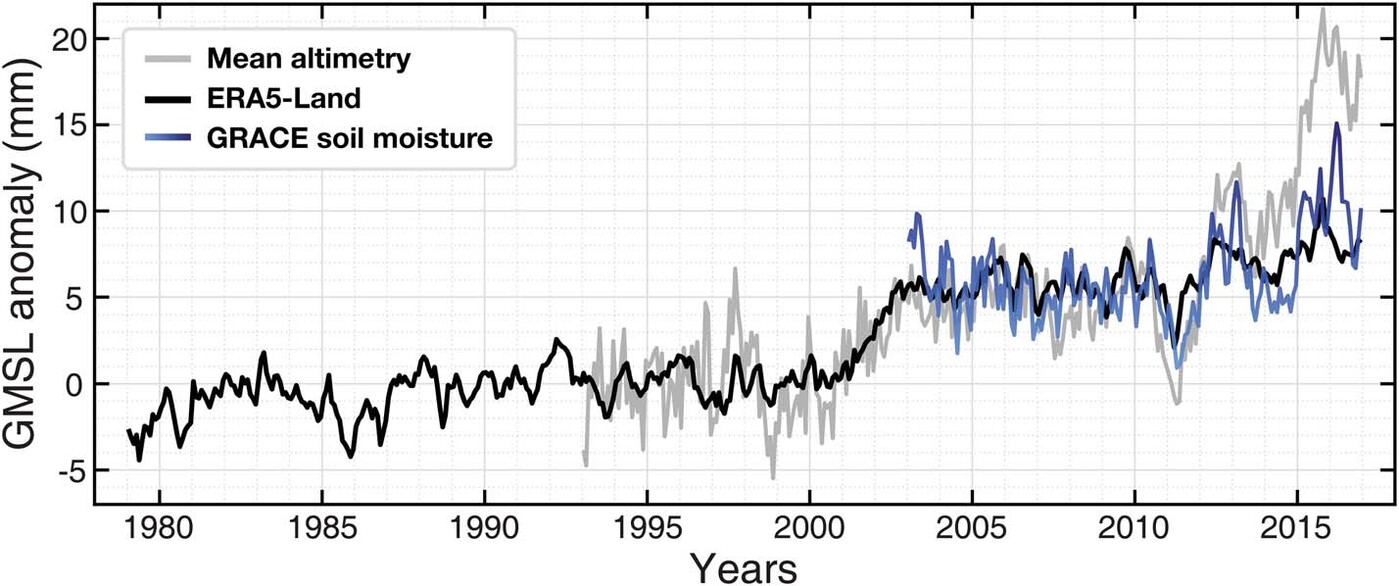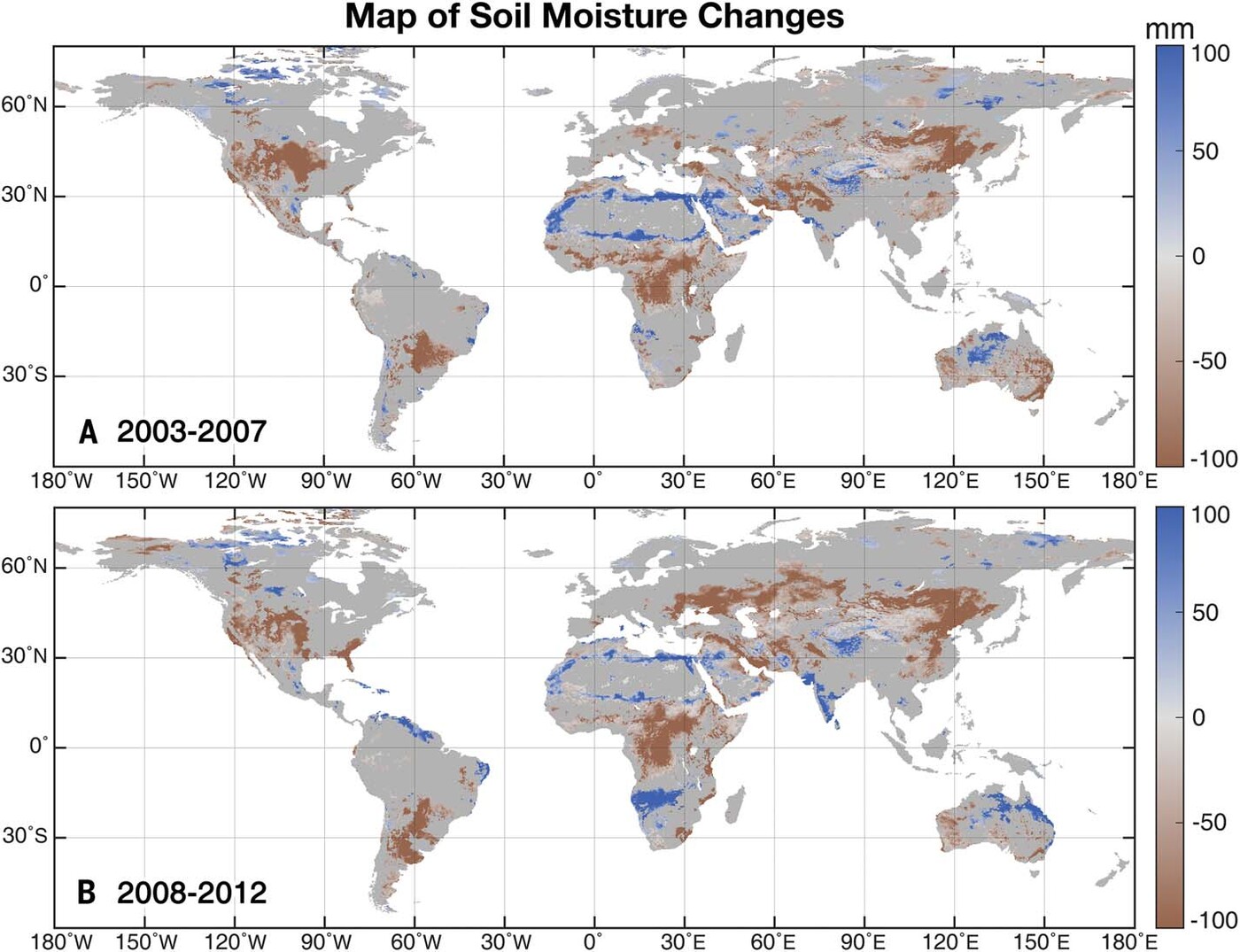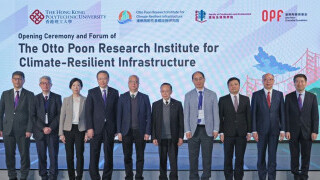An Irreversible Future: Soil Moisture Depletion Fuels Persistent Drought

Rising Sea Level and Earth’s Shifting Pole Signal Lasting Changes in Global Water Regimes
Study conducted by Prof. Jianli CHEN and international experts

The 21st century has brought about unprecedented changes in the Earth’s hydrological systems, with mounting evidence that these shifts are abrupt and potentially permanent. Prof. Jianli CHEN, Professor of the Department of Land Surveying and Geo-informatics and core member of the Research Institute for Land and Space at The Hong Kong Polytechnic University, and a team of international experts have utilised advanced reanalysis datasets and satellite observations and uncovered evidence of a dramatic depletion of terrestrial water storage—particularly soil moisture—across the globe. The research findings are published in Science [1]. This phenomenon is reflected in the sharp rise of global mean sea level (GMSL) and corroborated by measurable shifts in the Earth’s rotational pole. Together, these findings indicate a profound and possibly irreversible transition towards a drier global regime.
At the heart of this transformation is the interplay between rising atmospheric and oceanic temperatures and the terrestrial water cycle. As global temperatures climb, changes in precipitation patterns and evapotranspiration rates have led to significant alterations in land surface water fluxes. The European Centre for Medium-Range Weather Forecasts Reanalysis v5 (ERA5) soil moisture (SM) product provides a detailed account of these changes, revealing a sharp and sustained depletion of SM in the early 21st century.
Between 2000 and 2002 alone, global SM declined by approximately 1,614 gigatonnes—a figure that dwarfs the concurrent ice loss from Greenland, which amounted to about 900 gigatonnes between 2002 and 2006. The trend did not abate in subsequent years; from 2003 to 2016, an additional 1,009 gigatonnes of SM were lost and, as of 2021, there is little evidence of recovery.
This abrupt and persistent SM loss is not an isolated phenomenon. It is mirrored in two independent geophysical observations: the anomaly in global mean sea level and the shift in Earth’s rotational pole. Satellite altimetry data show a notable GMSL rise of approximately 4.4 millimetres during 2003-2016, which is a period of rapid SM depletion (Figure 1). This rise is particularly striking when compared to the rate attributed to Greenland’s ice mass loss, which is widely considered the largest single contributor to sea level rise in recent decades. The implication is clear: the loss of water from terrestrial reservoirs is now a major driver of sea level changes, with consequences that extend far beyond the immediate regions of drought.

Figure 1. GMSL anomalies observed and derived from SM storage. The black line shows the GMSL variations due to ERA5-Land SM change, the blue line shows GRACE-derived SM change, and the grey line is from 30-day means of altimetry datasets from Archiving, Validation and Interpretation of Satellite Oceanographic data, National Oceanic and Atmospheric Administration and University of Colorado.
The spatial SM distribution changes further underscore the global nature of this shift. ERA5-Land data, mapped for the periods before and after the early 2000s, reveal widespread and pronounced depletion across vast regions of East and Central Asia, Central Africa, and both North and South America. While some areas—such as parts of South America, India, Australia and North America—experienced modest replenishment, these are exceptions to a broader trend of drying.

Figure 2. Maps of global SM changes during (A) 2003-2007 and (B) 2008-2012 relative to 1995-1999. Blue indicates areas of SM gain and brown indicates areas of SM loss.
The SM maps change (Figure 2). Comparing 2003–2007 to 1995–1999 and extending to 2003–2021 relative to 1979–1999, they show that the regions affected by soil moisture loss have expanded over time, now encompassing much of Europe and the eastern United States. This spatial analysis provides compelling visual evidence of a global transition towards drier conditions, with the most severe impacts concentrated in regions already vulnerable to water scarcity.
The mechanisms driving this shift are complex and multifaceted. Extended periods of precipitation deficit, often associated with high barometric pressure systems and anomalous sea surface temperatures, have become more frequent and severe. These meteorological patterns, coupled with rising air temperatures, have increased evapotranspiration rates, further exacerbating drought conditions. The frequency of once-in-a-decade agricultural and ecological droughts has risen by a factor of 1.7 compared to the 1850–1990 mean and projections indicate that this trend will continue under various warming scenarios.
Unlike sudden natural disasters such as earthquakes or floods, droughts develop gradually, beginning with precipitation deficits that lead to the depletion of terrestrial water storage—including SM, groundwater and surface water in streams and lakes. Historically, the challenge of measuring terrestrial water storage, particularly groundwater and root-zone SM, limited our understanding of hydrological depletion at continental scales. The advent of satellite gravity missions, such as the Gravity Recovery and Climate Experiment (GRACE) and its successor GRACE Follow-On, has revolutionised our ability to monitor these changes. However, the satellite data only extend back to 2002, necessitating the use of additional proxies to reconstruct earlier trends.
One such proxy is the Earth’s polar motion (PM), which tracks changes in the planet’s rotational pole relative to its geographic pole. Mass redistribution within the Earth system—such as the movement of water from land to ocean—can induce measurable shifts in the pole’s position.
Prof. Chen’s research utilised both GMSL and PM data from 1992 to 2016, alongside ERA5-Land SM records, to elucidate patterns of global terrestrial water storage depletion. The findings are striking. Earth’s pole shifted by approximately 45 centimetres (about 15 milliarcseconds) up until 2012, a movement closely aligned with the timing and magnitude of SM loss. By comparing the excitation terms of polar motion derived from SM variations with observed PM data (after accounting for other contributing factors), the study demonstrates a strong correspondence, thereby validating SM depletion estimates.
The drivers behind the observed shift in terrestrial water storage are rooted in changes to the global water balance. ERA5 data show a steep decline in land precipitation after 2000, a trend corroborated by gauge-based and blended satellite-gauge precipitation datasets. While global evapotranspiration also declined, the reduction was less pronounced, resulting in a sharp drop in the precipitation-evapotranspiration anomaly. At the same time, potential evapotranspiration—a measure of atmospheric demand for water—has increased significantly, driven by rising temperatures and atmospheric vapour pressure deficit. This combination of reduced precipitation and heightened evaporative demand has led to a persistent SM deficit, with little prospect of recovery.
The convergence of evidence from SM records, sea level anomalies and Earth’s pole shift underscores the reality of a new hydrological normal—one defined by persistent drought, declining water availability and far-reaching impacts on ecosystems and human societies. As the scientific community continues to refine its models and observational tools, these findings serve as both a warning and a call to action; we have entered the era of rapid and irreversible hydrological change.
Prof. Chen has been recognised by Stanford University as one of the top 2% most-cited scientists worldwide (career-long) in the field of meteorology and atmospheric sciences for five consecutive years, from 2020 to 2024, and one of the top 2% most-cited scientists worldwide (single-year) for six consecutive years, from 2019 to 2024. He received the US Presidential Early Career Awards for Scientists and Engineers in 2005 and has been elected as an American Geophysical Union Fellow in 2024.
| References |
|---|
[1] Seo, K., Ryu, D., Jeon, T., Youm, K., Kim, J., Oh, E. H., Chen, J., Famiglietti, J. S., Wilson, C. R. (2025). Abrupt sea level rise and Earth’s gradual pole shift reveal permanent hydrological regime changes in the 21st century. Science 387, 1408-1413(2025). DOI:10.1126/science.adq6529
 | Prof. Jianli CHEN |




